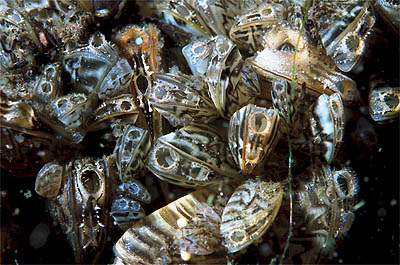The march of the Zebra Mussel continues West. Veligers are the early-stage microscopic larvae and they’ve been found in the length of the Red River from Wahpeton to Pembina. Read the full news release below and remember to clean your boat!
— Official News Release, ND Game & Fish —
Numerous zebra mussel veligers have been discovered at several locations along the Red River between North Dakota and Minnesota, according to North Dakota Game and Fish Department aquatic nuisance species coordinator Fred Ryckman.
In a survey conducted June 23-24 at six sites along the length of the river from Wahpeton to Pembina, Ryckman said that a significant number of zebra mussel veligers were found at each location. The survey was conducted by Valley City State University; samples were sent to the Montana Fish, Wildlife and Parks veliger lab for analysis.
Veligers – the early life stage of mussels – are microscopic larvae that adult mussels release into the water. They float with the current and can attach in great numbers to hard surfaces such as rocks, boat docks and bridge pilings, and as adults can clog pipes such as those used for municipal or industrial water supply systems. They also feed on organisms that are primary food sources for newly hatched game fish.
This is the first time that veligers were discovered at any location downstream from Wahpeton, and in quantities of more than only a couple of specimens. Surveillance efforts on the Red River in the past five years detected the presence of zebra mussel veligers in 2010, 2011 and 2014, all found at the same single site near Wahpeton, Ryckman said. In addition to the location at Wahpeton, veligers were also documented in the recent survey at Pembina, Drayton, Grand Forks, Fargo and Abercrombie.
“Although these results are not totally surprising considering the recent findings of large numbers of zebra mussel veligers in the Red River at the Canadian border, and in past years near Wahpeton in the Otter Tail River in Minnesota, the results are certainly surprising in that so many veligers were detected at each of the six sampled sites,” Ryckman said. “And it’s even more incredible considering that in similar sampling over the past several years we’ve only detected about a half dozen veligers in total.”
The only known population of zebra mussels within the Red River basin in the United States is an established population of adult zebra mussels in the Otter Tail River watershed in Minnesota, upstream of where the Otter Tail and Bois de Sioux join together to form the Red at Wahpeton-Breckenridge. Ryckman says that although the Otter Tail River was the likely source of previous veliger discoveries, the volume of veligers discovered this year along the entire length of the river has biologists questioning if there aren’t undiscovered colonies of adult zebra mussels elsewhere within the Red River watershed.
The key now is for people using the Red to be extra careful about transporting any water away from the river, Ryckman said. “There really isn’t anything we can do to remove the veligers or any adult zebra mussels from the river,” he added, “but we can be on alert and do everything we can to prevent them from being moved to other bodies of water.”
In addition to following the ANS rules and regulations when exiting the river, Ryckman urges local entities and water recreationists using the Red to look for and report any suspected adult zebra mussels that they may find.
If mussels are found, citizens are asked to report findings immediately to a local Game and Fish Department district office. Pictures and life history of zebra mussels are available on the 100th Meridian Initiative website at 100thmeridian.org/.
More information on zebra mussels, other aquatic nuisance species and related regulations is available on the Game and Fish website atgf.nd.gov/ans.



